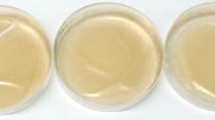Abstract
Three kinds of tree bark extractives from trembling aspen (Populus tremuloides) (AE), lodgepole pine (Pinus contorta) (LE), and western red cedar (Thuja plicata) (RE) were produced and used as antioxidants. The antioxidation activities of those extractives were evaluated and compared with commercial antioxidant butylated hydroxytoluene (BHT). The obtained extractives were applied as natural photostabilizers to produce wood flour/polypropylene (WF/PP) composites at an addition level of 2 wt%. The composites were subjected to QUV accelerated weathering tester for a total of 1200 h. The changes in surface color, surface morphology, and surface chemistry of composites were investigated during the exposure. The results showed that all bark extractives alleviated the photodegradation of composites successfully. Among them, RE was proved to be the most effective. It exhibited excellent UV absorption and similar free-radical inhibition ability compared with BHT. Consequently, composites containing RE exhibited less discoloration, less severe surface cracking, and less changes in surface chemistry during the whole weathering process. Overall, these results revealed that RE had great potential as a natural photostabilizer in polymer systems.
Similar content being viewed by others
References
A. Ashori, Bioresource Technol., 99, 4661 (2008).
J. M. Park, S. T. Quang, B. S. Hwang, and K. L. DeVries, Compos. Sci. Technol., 66, 2686 (2006).
J. Chen, Z. Teng, and J. Wu, Polym. Compos., 38, 2140 (2017).
J. M. Park, P. G. Kim, J. H. Jang, Z. Wang, B. S. Hwang, and K. L. DeVries, Compos. Part B Eng., 39, 1042 (2008).
T. Ratanawilai, K. Nakawirot, A. Deachsrijan, and C. Homkhiew, Fiber. Polym., 15, 2160 (2014).
W. Wang, Y. Peng, M. Zammarano, W. Zhang, and J. Li, Polymers, 9, 615 (2017).
M. Kargar, A. H. Behravesh, and H. Mohammad Taheri, Polym. Compos., 37, 1674 (2016).
N. M. Stark and L. M. Matuana, Polym. Degrad. Stab., 92, 1883 (2007).
J. S. Fabiyi and A. G. McDonald, Compos. Part A Appl. Sci., 41, 1434 (2010).
C. Homkhiew, T. Ratanawilai, and W. Thongruang, Ind. Crop. Prod., 56, 52 (2014).
I. Yakimets, D. Lai, and M. Guigon, Polym. Degrad. Stab., 86, 59 (2004).
Y. Amintowlieh, C. Tzoganakis, S. G. Hatzikiriakos, and A. Penlidis, Polym. Degrad. Stab., 104, 1 (2014).
U. Müller, M. Rätzsch, M. Schwanninger, M. Steiner, and H. Zöbl, J. Photoch. Photobio. B, 69, 97 (2003).
L. M. Matuana, S. Jin, and N. M. Stark, Polym. Degrad. Stab., 96, 97 (2011).
K. K. Pandey and T. Vuorinen, Polym. Degrad. Stab., 93, 2138 (2008).
P. Nzokou and D. P. Kamdem, Color Res. Appl., 31, 425 (2006).
T. C. Chang, H. T. Chang, C. L. Wu, H. Y. Lin, and S. T. Chang, Polym. Degrad. Stab., 95, 1518 (2010).
T. C. Chang, H. Y. Lin, S. Y. Wang, and S. T. Chang, Polym. Degrad. Stab., 105, 42 (2014).
T. C. Chang, N. C. Hsiao, P. C. Yu, and S. T. Chang, Wood Sci. Technol., 49, 811 (2015).
T. C. Chang and S. T. Chang, Wood Sci. Technol., 51, 1133 (2017).
P. N. Diouf, T. Stevanovic, and A. Cloutier, Wood Sci. Technol., 43, 457 (2009).
P. N. Diouf, T. Stevanovic, and A. Cloutier, Food Chem., 113, 897 (2009).
Z. Huang and N. Yan, Wood Fiber Sci., 46, 167 (2014).
M. Yalcin, H. Pelit, C. Akcay, and N. Cakicier, Color. Technol.133, 334 (2017).
E. D. Tomak, F. Arican, O. Gonultas, and E. D. S. Parmak, Polym. Degrad. Stab., 151, 152 (2018).
E. Aspé and K. Fernández, Ind. Crop. Prod., 34, 838 (2011).
S. Zhang, L. Su, L. Liu, and G. Fang, Ind. Crop. Prod., 77, 451 (2015).
K. R. Aadil, A. Barapatre, S. Sahu, H. Jha, and B. N. Tiwary, Int. J. Biol. Macromol., 67, 220 (2014).
N. M. Stark and L. M. Matuana, Polym. Degrad. Stab., 91, 3048 (2006).
C. Badji, L. Soccalingame, H. Garay, A. Bergeret, and J. C. Bénézet, Polym. Degrad. Stab., 137, 162 (2017).
Y. Chen, N. M. Stark, M. A. Tshabalala, J. Gao, and Y. Fan, Materials, 9, 610 (2016).
D. Rasouli, N. T. Dintcheva, M. Faezipour, F. P. La Mantia, M. R. M. Farahani, and M. Tajvidi, Polym. Degrad. Stab., 133, 85 (2016).
B. K. Deka and T. K. Maji, Compos. Part A Appl. Sci., 42, 2117 (2011).
S. Butylina, O. Martikka, and T. Kärki, Polym. Degrad. Stab., 120, 10 (2015).
S. Butylina, M. Hyvärinen, and T. Kärki, Compos. Part A Appl. Sci., 43, 2087 (2012).
C. M. Popescu, M. C. Popescu, and C. Vasile, Int. J. Boil Macromol, 48, 667 (2011).
R. Gadioli, J. A. Morais, W. R. Waldman, and M. A. De Paoli, Polym. Degrad. Stab., 108, 23 (2014).
K. Zheng, H. Tang, Q. Chen, L. Zhang, Y. Wu, and Y. Cui, Polym. Degrad. Stab., 112, 27 (2015).
A. A. Morandim-Giannetti, J. A. M. Agnelli, B. Z. Lanças, R. Magnabosco, S. A. Casarin, and S. H. Bettini, Carbohydr. Polym., 87, 2563 (2012).
W. A. N. N. A. Ammawath, Y. B. Che Man, R. B. Abdul Rahman, and B. S. Baharin, J. Am. Oil Chem. Soc., 83, 187 (2006).
P. C. Babu, N. Sundaraganesan, Ö. Dereli, and E. Türkkan, Spectrochim. Acta Part A, 79, 562 (2011).
V. Bondet, W. Brand-Williams, and C. L. W. T. Berset, LWT-Food Sci. Technol., 30, 609 (1997).
Acknowledgements
The authors would like to express their thanks to the Fundamental Research Funds for the Central Universities (BLX201822), Beijing Forestry University Outstanding Young Talent Cultivation Project (2019JQ03013), Natural Sciences and Engineering Research Council of Canada (NSERC), and China Postdoctoral Science Foundation (2018M641224) for financial support of this work. The authors also are grateful to Dr. Heyu Chen, Dr. Peiyu Kuo, and Shiang Law at University of Toronto for the preparation of bark extractives and composites, as well as the characterization of antioxidation activity of bark extractives.
Author information
Authors and Affiliations
Corresponding author
Rights and permissions
About this article
Cite this article
Peng, Y., Yan, N. & Cao, J. Utilization of Three Bark Extractives as Natural Photostabilizers for the Photostabilization of Wood Flour/Polypropylene Composites. Fibers Polym 21, 1488–1497 (2020). https://doi.org/10.1007/s12221-020-9694-1
Received:
Revised:
Accepted:
Published:
Issue Date:
DOI: https://doi.org/10.1007/s12221-020-9694-1




